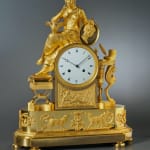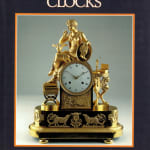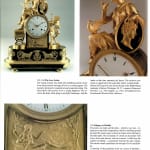
Hans Ottomeyer and Peter Pröschel, “Vergoldete Bronzen”, 1986, p. 377, pl. 5.15.3, illustrating a clock of the same model in the Badische Landesmuseum in Karlsruhe. And p. 377, pl. 5.15.12, illustrating a design for a variant model by François-Louis Savart in the Bibliothèque Nationale, Cabinet d’Estampes, Paris.

Description: Hans Ottomeyer and Peter Pröschel, “Vergoldete Bronzen”, 1986, p. 377, pl. 5.15.3.

Elke Niehüser, “French Bronze Clocks”, 1999, front cover.

Elke Niehüser, “French Bronze Clocks”, 1999, front cover and p. 120. Pls. 193-194, illustrating a clock of the same model, likewise without a dial signature.
François-Louis Savart (attributed to)
Further images
Literature
Hans Ottomeyer and Peter Pröschel, “Vergoldete Bronzen”, 1986, p. 377, pl. 5.15.3, illustrating a clock of the same model in the Badische Landesmuseum in Karlsruhe. And p. 377, pl. 5.15.12, illustrating a design for a variant model by François-Louis Savart in the Bibliothèque Nationale, Cabinet d’Estampes, Paris.
Elke Niehüser, “French Bronze Clocks”, 1999, front cover and p. 120. Pls. 193-194, illustrating a clock of the same model, likewise without a dial signature.
Jean-Nerée Ronfort and Jean-Dominique Augarde, “A l’Ombre de Pauline La Résidence de l’Ambassadeur de Grande-Bretagne à Paris”, 2001, p.70, pl. 52, illustrating an identical clock placed in situ on the mantlepiece in the Salon Jaune in the British Embassy, Paris.
A very fine Empire gilt and part patinated bronze mantel clock of eight day duration housed in a case attributed to François-Louis Savart after a model by the same bronzier. The white enamel dial with Roman and Arabic numerals and blued steel moon-style hands for the hours and minutes. The movement with silk thread suspension, anchor escapement, striking on the hour and half hour on a single bell, with outside count wheel. The beautiful case showing a young woman in classical dress seated upon the dial drum who holds in her left hand a portrait medallion of her lover while looking down toward a carrier pigeon who sits upon her knee and holds a note she has just written to her love. She rests her feet on an ancient Greco Roman style x-shaped stool or tabouret which stands to the left of the dial plinth while to the right is a tripod table with three winged monopodia supports, each with a female bust and head and feet of a lion, on top of the table rests a writing box with quill pen and a flaming candle in a candlestick. Below the dial, within the pedestal frieze is a young shepherd holding a panpipe, reclining beneath trees, who receives a message from the young woman held in the beak of the same carrier pigeon. The rectangular base with rounded ends cast at centre with a vase of flowers issuing from an anthemion flanked either side by a pair of sheep, with further mounts to either end. The whole on bun feet
Paris, date circa 1810
Height 50.5 cm, width 41 cm, depth 16 cm.
Elke Niehüser chose an identical clock to this for the front cover of her book “French Bronze Clocks”, 1999 (English translation from the German). The model for the case is after a design by the Parisian bronze maker François-Louis Savart (1780-1828) which is inscribed M Savart fabrique de bronze rue Philippaux no 11 and is housed in the Bibliothèque Nationale, Paris. Savart’s original design follows the same basic form as here though the young woman sits on an antique chair astride the dial; in turn the dial is not raised on a pedestal and thus although there is the same tripod table to the right of the dial, there is no stool on the left, furthermore both the figure of the shepherd and the pair of sheep appear together on the frieze base. A clock based on that original design can be found today in the Museo de Relojes Jerez de la Frontera.
In addition to an identical clock in the Badische Landesmuseum in Karlsruhe is another in the British Embassy Paris. It was originally owned by Napoleon Bonaparte’s sister Princess Pauline Borghèse (1780-1825) and was housed at her Paris residence at Hôtel Borghèse. Her residence was to become the British Embassy after it and all the Princess’s art collection were purchased in 1814 by the Duke of Wellington for the British government. The inventory drawn up in 1814 lists the comparable clock in the Salon Jaune, where it still stands today on the mantlepiece flanked by a pair of candelabra attributed to Pierre-Philippe Thomire. Other similar or variant clocks include an example signed on the dial Le Roy Horloger De S.A.I. Madame Mère de l’Impéreur, which was in the D. Brunet Collection. A second was sold in Paris by M. Rieuner & Bailly-Pommery on 6th June 1990, lot 93; a third was offered by Sotheby’s New York on 6th November 1982, lot 12, while two others were sold by Koller, Switzerland, one in November 1995, lot 4032 and another by the same auction house when, on 22nd June 2006 (lot 1315), they sold an example based on Savart’s original design fitted with a movement by Dieudonné Kinable. Another almost identical example to the present, shows the young woman holding a tablet (instead of a portrait medallion), on which are inscribed the words: Ce Messager D’amour Fait Couler D’heureux jours, (This love letter brought happy days). That clock, which is signed on the dial Lacroix à Paris, was sold by Chiswick Auctions, West London, 24th May 2017, lot 111.
Like many clocks of the period, the subject of its case revolves around the theme of love while the complex composition includes decorative elements that looked back to antiquity. The case design is often referred to as ‘The Love Letter’. It shows a young woman in antique costume who has just composed a love letter which she has given to a carrier pigeon. The subject of her heart’s desire is a young shepherd whose portrait she holds in her hand and who again appears below the dial where, reclining in an arcadian setting, he receives her message via the bird. The theme of the shepherd is repeated on the base where we see a pair of sheep flanking a vase of flowers. Further reference to the letter is shown by the writing box and quill on the tripod table, while the lit candle in the candlestick alludes to the heat of the two lovers’ passion.
The tripod table, together with the x-shaped stool or tabouret are of specific interest since these were inspired by ancient Greco Roman prototypes and were one of a number of artefacts from antiquity that shaped the decorative arts of the period. In all probability Savart’s designs for these two pieces of furniture were based on designs by Napoleon’s chief architects and ornamentalistes Charles Percier (1764-1838) and Pierre François Léonard Fontaine (1762-1853) whose detailed studies for interiors and furnishings were widely disseminated in their Recueil des Décorations Intérieures, first appearing as a series in 1801. Percier and Fontaine’s designs were instrumental in shaping the Directoire and Empire style and gave rise to new items of furniture. Among them were an array of similar x-shaped tabourets, notably one by Jacob Frères of 1800, which has the same lion paw feet and decoration at the joint of the X, which formed part of a series of furniture supplied to Château de Malmaison circa 1800 (illustrated in Jean-Pierre Samoyault, “Mobilier Français Consulat et Empire”, 2009, p. 54, pl. 65). In the same book Samoyault also illustrates a number of other items of furniture that feature similar monopodia winged supports that we see on the tripod table, for instance on a bureau made for Napoleon Bonaparte by Jacob Frères after a design by Percier and Fontaine for the Palais des Tuileries (ibid, p. 125, pl. 215).
The bronzier François-Louis Savart (1780-828) who produced a variety of luxury bronzes from candelabra to clocks, would have been well aware of designs by Percier and Fontaine and others as well as contemporary furniture based on those designs. Savart was born on 6th June 1780 and worked for most of his career in Paris where, when he designed the original model for this clock, he was established at no 11 rue Philippaux. His inventory drawn after his death on 6th December 1828 notes his address as rue de Limoges, no. 8. He was subsequently buried in the cemetery of Père Lachaise, where upon his grave is a portrait bust of him modelled by the sculptor Sylvestre-Joseph Brun.





